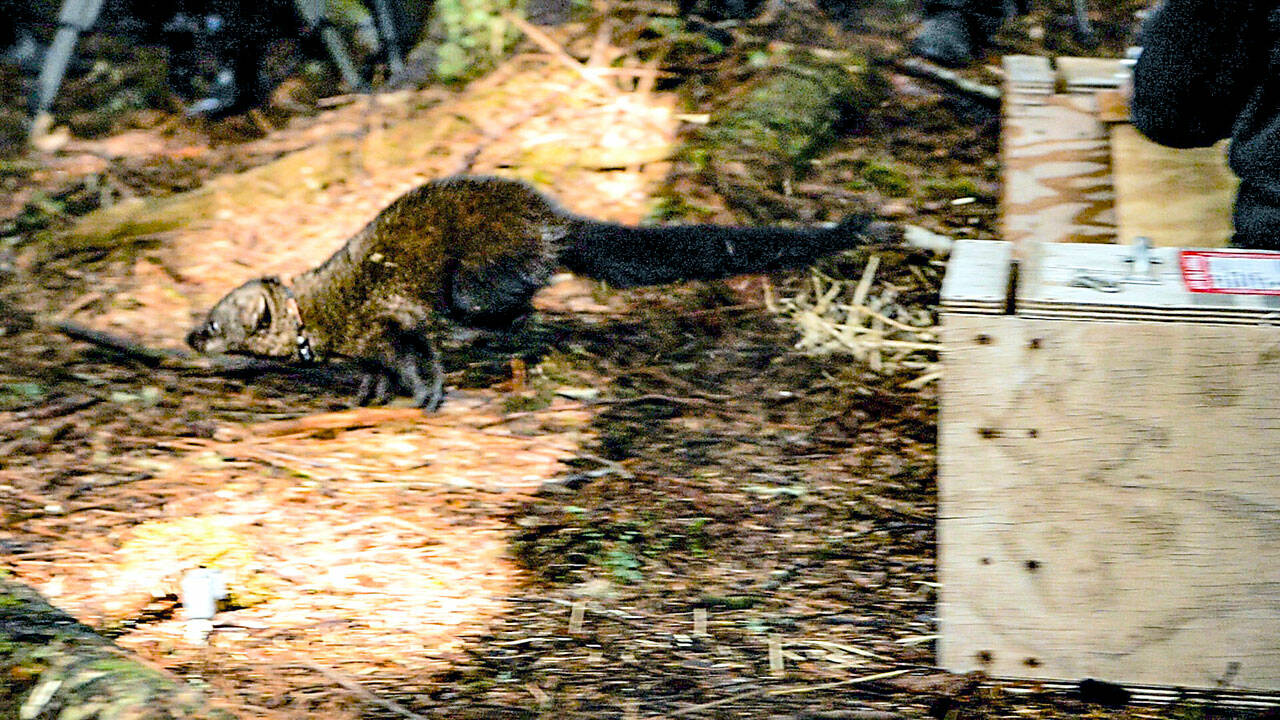A release of seven fishers from Alberta, Canada into Olympic National Park earlier this month is part of a program to increase the genetic diversity of the once-decimated native species.
Five were released into the wild at Lake Ozette and two were released near Sol Duc, said Patti Happe, wildlife branch chief of Olympic National Park (ONP), on Nov. 12.
“They were a good mix of male and female,” she said.
The park and other partners in the reintroduction of the species aim to release 20 members of the Alberta fisher population into the park and Olympic National Forest by the end of the year, Happe said.
“We have four already waiting,” in Alberta, she said.
After three more are captured, another release will be planned, she added.
Fishers — a member of the mustelid or weasel family roughly the size of a house cat that feeds on rodents, hares and porcupines — were extirpated from Washington state by the 1930s due to over-trapping, poisoning and fragmentation of their forest habitat.
Reintroduction of fishers captured in British Columbia began in 2008. The Washington Fisher Reintroduction Project met its goal in early 2020, releasing more than 250 fishers across the Olympic and Cascade ranges, according to an ONP press release.
The population has flourished, Happe said, judging by a 2016 study that found fishers had dispersed throughout the region, with third-generation fishers being born.
However, analysis of the DNA samples from hair snares also revealed a loss of genetic diversity due to a smaller-than-desired percentage of the females successfully denning, the park reported.
“A lot of the same females were showing up,” Happe said. “The genetic lab said that, for long-term persistence of the population, it would be best to put new genes in every 10 years.
The lab recommended 10 fishers from an area other than British Columbia be released each time to improve the genetic diversity.
The project partners decided to release 20 to ensure success, Happe said.
“The release of these fishers on the Olympic Peninsula, where the statewide journey for fisher reintroduction began, marks the last step to ensure the long-term success of this effort,” according to the ONP press release.
This latest fisher release is part of an ongoing partnership led by the state Department of Fish and Wildlife, the National Park Service, U.S. Geological Survey and Conservation Northwest to restore the elusive carnivores to Washington’s Olympic Peninsula and Cascade Mountains.
The Ozette area was chosen for the latest release due to the ongoing partnership with the Makah Tribe since 2008 and the Makah Tribe’s continued research on the fisher population in the Ozette to Neah Bay regions.
“Watching fishers return to the forests of the Olympic Peninsula is truly inspiring,” said Olympic National Park Superintendent Sarah Creachbaum in the press release.
“As they scamper through lush ferns and back into our biodiverse landscape, you can tell they belong here and will enrich our natural heritage and support the overall health of this ecosystem.”
Funding for this effort is primarily from the public and partner agencies and started with a donation from Olympic Park Associates and Washington’s National Park Fund.
Support and funding for the latest round of fisher transplants also comes from the National Park Service, state Fish and Wildlife Department, Conservation Northwest, Northwest Trek Wildlife Park and Point Defiance Zoo & Aquarium, Woodland Park Zoo among others.
“Fishers are vulnerable in Washington, and we are working creatively alongside partners to bring them back to their native range,” said Kelly Susewind, director of Fish and Wildlife.
“Fisher restoration is a great example of our agency’s mission and how partnership is the key to conservation success.”
Regional nonprofit Conservation Northwest has coordinated work with Canadian trappers to humanely acquire the fishers for release, which are then recorded, health-screened and temporarily housed by The Calgary Zoo before being transported to Washington.
“Fisher reintroduction has been a model collaboration; a public-private partnership that has grown to include local communities, Indigenous nations, forestry and others,” said Dave Werntz, science and conservation director for Conservation Northwest.
“It’s inspiring to see more of these charismatic creatures returned to our state, and exciting to consider the possibilities that collaborative conservation holds for Washington’s natural heritage.”
While presently listed as an endangered species by the state, Washington’s fisher population was not listed under the federal Endangered Species Act during a recent status review due to the progress of ongoing reintroduction efforts.
A voluntary fisher conservation program is available to private forest landowners that provides regulatory assurances should the species become listed. To date, more than 60 landowners have enrolled 3.32 million acres in fisher conservation.
For more on that program, as well as more information about efforts in the Olympics and the Cascades, see wdfw.wa.gov/species-habitats/species/pekania-pennanti#conservation.



